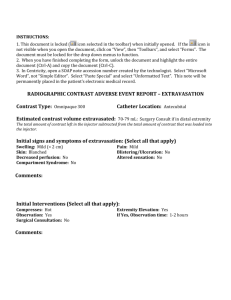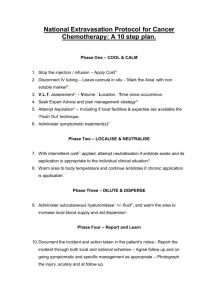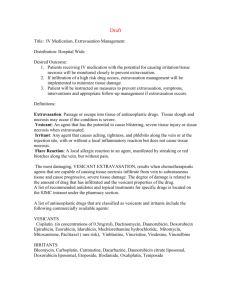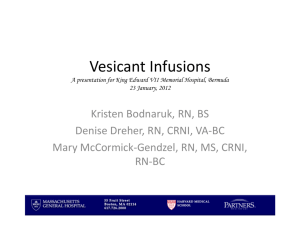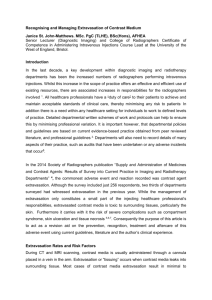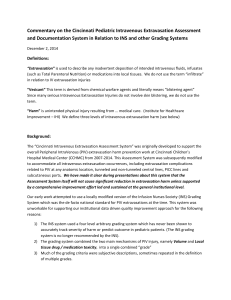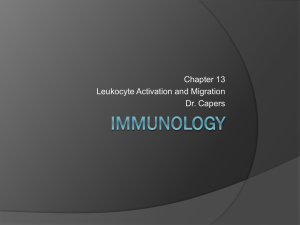Venous Extravasation Assessment System Poster
advertisement
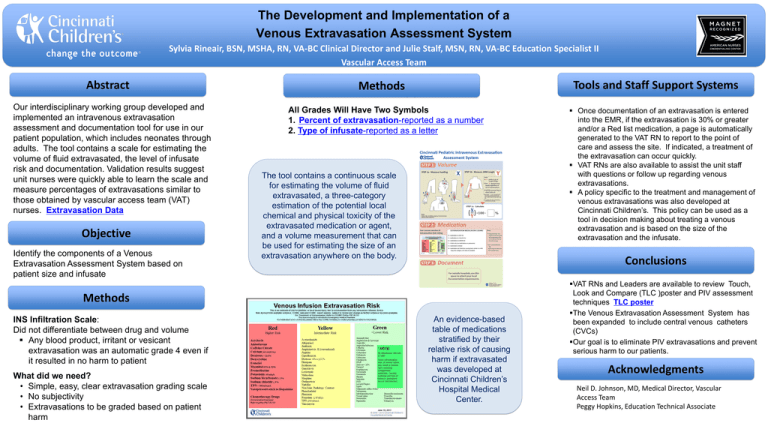
The Development and Implementation of a Venous Extravasation Assessment System Sylvia Rineair, BSN, MSHA, RN, VA-BC Clinical Director and Julie Stalf, MSN, RN, VA-BC Education Specialist II Vascular Access Team Abstract Our interdisciplinary working group developed and implemented an intravenous extravasation assessment and documentation tool for use in our patient population, which includes neonates through adults. The tool contains a scale for estimating the volume of fluid extravasated, the level of infusate risk and documentation. Validation results suggest unit nurses were quickly able to learn the scale and measure percentages of extravasations similar to those obtained by vascular access team (VAT) nurses. Extravasation Data Objective Identify the components of a Venous Extravasation Assessment System based on patient size and infusate Tools and Staff Support Systems Methods Institution(s) All Grades Will Have Two Symbols 1. Percent of extravasation-reported as a number 2. Type of infusate-reported as a letter The tool contains a continuous scale for estimating the volume of fluid extravasated, a three-category estimation of the potential local chemical and physical toxicity of the extravasated medication or agent, and a volume measurement that can be used for estimating the size of an extravasation anywhere on the body. Conclusions Methods INS Infiltration Scale: Did not differentiate between drug and volume Any blood product, irritant or vesicant extravasation was an automatic grade 4 even if it resulted in no harm to patient What did we need? • Simple, easy, clear extravasation grading scale • No subjectivity • Extravasations to be graded based on patient harm Once documentation of an extravasation is entered into the EMR, if the extravasation is 30% or greater and/or a Red list medication, a page is automatically generated to the VAT RN to report to the point of care and assess the site. If indicated, a treatment of the extravasation can occur quickly. VAT RNs are also available to assist the unit staff with questions or follow up regarding venous extravasations. A policy specific to the treatment and management of venous extravasations was also developed at Cincinnati Children’s. This policy can be used as a tool in decision making about treating a venous extravasation and is based on the size of the extravasation and the infusate. An evidence-based table of medications stratified by their relative risk of causing harm if extravasated was developed at Cincinnati Children’s Hospital Medical Center. VAT RNs and Leaders are available to review Touch, Look and Compare (TLC )poster and PIV assessment techniques TLC poster The Venous Extravasation Assessment System has been expanded to include central venous catheters (CVCs) Our goal is to eliminate PIV extravasations and prevent serious harm to our patients. Acknowledgments Neil D. Johnson, MD, Medical Director, Vascular Access Team Peggy Hopkins, Education Technical Associate Click to return to Poster Assessment/Grading of Extravasation PIV Extravasation Scenario RN palpates the swelling at the widest dimension. It measures 3cm. X = 3cm RN measures length from longest fingertip to axilla. It measures 30 cm. Y = 30cm Click to return to poster Click to return to poster Click to return to poster

